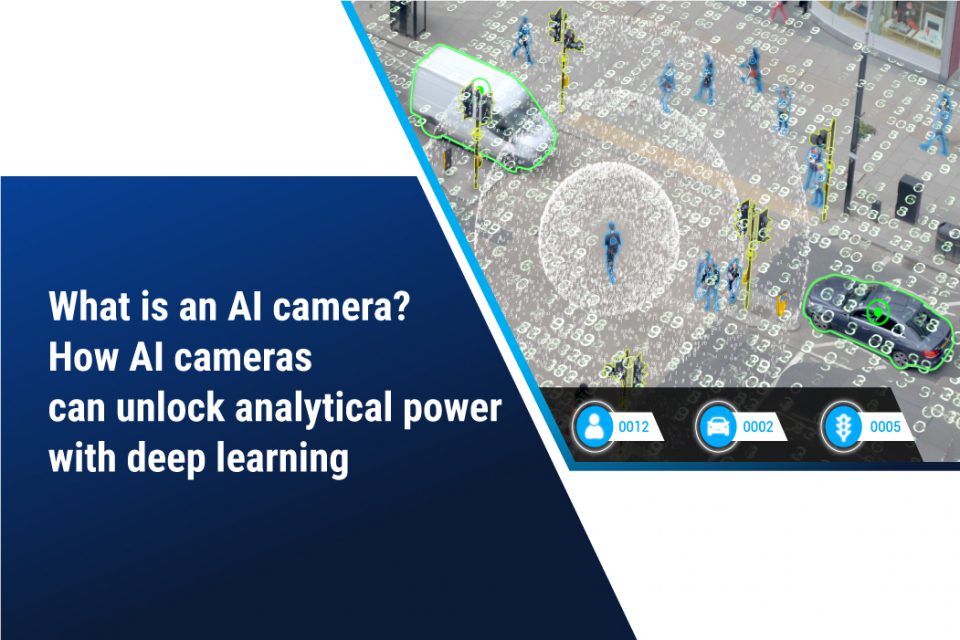Deep Learning (DL) has been a transformational force in changing what embedded vision can do. However, let’s first compare it with Machine Learning (ML). ML is the ability of machines to recognize data patterns while constantly learning from them. Even though ML algorithms are not explicitly programmed, they still need predefined rules to perform specific tasks and understand patterns.
DL is a more advanced and sophisticated subset of ML based on an artificial neural network. DL algorithms demand far less human intervention, as the desired application outcome is provided as input for the machine to work out the details of achieving it. That’s why DL-based applications rely on large datasets to make real-time intelligent interpretations.
In this blog, you’ll gain insights into DL-powered AI cameras, how they work, and where they are used. You’ll also learn about SMARTOdin22_PoE_IP67, e–con Systems’ state-of-the-art smart AI camera.
What is a DL-Powered AI Camera?
A deep learning camera (or an AI camera) is equipped with AI power to understand classifications like humans, vehicles, and more. Understanding such classifications, they have data-rich decision-making capabilities to detect movement and capture high-quality images while avoiding irrelevant information.
When it comes to deep learning, many tend to limit the discussion to the software and algorithms used to implement DL/ML techniques. However, hardware components play an equally significant part in collecting the necessary data for these computer applications or edge-based processors to analyze and make decisions.
Read: A detailed look at using AI in embedded smart cameras
Major Functions of a Deep Learning AI Camera
A deep learning AI camera has integrated imaging features – including classifying, processing, and segmenting images. Following are some of the most important functions and capabilities of an AI camera:
Image classification
As earlier addressed, AI cameras can automatically tag images to several classifications to identify and capture the right image at the right time. For instance, it can be used to detect damaged goods on the assembly line inside a warehouse.
Image recognition
AI cameras can assign every pixel to a particular classification – thereby enabling quick identification of multiple objects on a single image. This feature enables instant object recognition – helping determine sizes, shapes, types, and other specifications of objects. An example of this would be automatically identifying objects dropped into a shopping trolley in an autonomous checkout system.
Image processing
In a deep learning camera system, while the camera captures image data, high-end processors, like the NVIDIA Jetson series, process this information to derive inferences on the edge. This processed data can be immediately used for automated decision-making.
Read: What is edge AI and what are its applications?
What is the Role of TOPS in AI Cameras?
TOPS, which stands for Tera Operations Per Second, is a metric used to quantify the computational power of processors. The role of TOPS in AI cameras is crucial, as it directly impacts the ability to perform AI-related tasks.
High TOPS values in a processor indicate better performance capabilities, which make it suitable for applications requiring real-time, intelligent processing. Key components of TOPs in AI cameras include:
- Better imaging: The computational power quantified by TOPS can be leveraged to enhance imaging capabilities such as noise reduction, dynamic range adjustment, and image stabilization. Therefore, AI cameras become more adaptable to various lighting conditions.
- Performance measurement:TOPS provides a direct measure of the AI processor’s ability to perform one trillion operations per second. This is critical in AI cameras, where processing vast amounts of data in real time is necessary for tasks such as image recognition, object detection, and video analysis.
- AI task efficiency:Higher TOPS indicate a processor’s higher capacity to handle complex AI algorithms. Hence, it helps execute advanced AI features like real-time facial recognition with minimal latency.
- Energy optimization:AI cameras often operate in environments where power consumption is a concern. Processors with higher TOPS per watt are more energy-efficient, enabling AI cameras to perform more computations with less power.
Key Embedded Vision Use Cases of an AI Camera
Traffic management
Smart traffic systems are crucial to modern urban planning. They prevent traffic congestion and overcrowding while significantly reducing the number of fatal accidents. By incorporating deep learning-based image segmentation functionality, these systems can zero in on visual information in real time.
Hence, it becomes hassle-free for an AI camera to segment/track vehicles, estimate traffic density, monitor adherence to speed limits, etc.
Read: Choosing the right camera solution for smart traffic management
Smart farming
Performance is in the details for auto farming systems because even the slightest misinformation can trigger business loss or overspending. So, their AI camera solutions rely on powerful deep learning algorithms.
These AI cameras are expected to capture minuscule details like crop growth, soil quality, diseases, etc., and automate critical parts of the farming process.
Read: How cameras enable vision in new-age agricultural robots
Automated sports broadcasting
AI cameras have flipped the script on how sporting events are broadcast to audiences all over the world. From soccer and baseball to cricket and basketball, easy-to-deploy AI camera systems are being used to capture and stream live footage – with integrated network connectivity.
In addition, smart cameras can run deep learning algorithms to analyze video streams automatically, offering valuable player input to coaches and team managers.
Read: How multi-camera systems are used in sports broadcasting
Security and smart surveillance
The surge of smart cities has caused the demand for continuous surveillance to ensure citizen safety. Also, considering the boom of business infrastructure, ensuring 24X7 security in and around the premises can no longer be compromised. So, AI camera solutions have become very popular in smart surveillance applications such as parking lot management and street monitoring.
Smart AI cameras can capture images and videos to create security protocols by applying deep learning techniques – from monitoring and analyzing crowds with facial recognition to processing videos in real-time to identify threats and raise alarms.
Read: Choosing the right image sensor for smart surveillance applications
Medical
In the healthcare sector, embedded vision systems in AI cameras can help with patient monitoring, surgical assistance, and diagnostic processes. They monitor patient vitals, detect falls, and ensure patient safety in hospitals.
During surgeries, AI cameras provide enhanced imaging for precision and guidance. They also assist in analyzing medical images to detect diseases early.
Read: How cameras and AI are replacing traditional diagnostics in digital pathology
Read: How cameras and Artificial Intelligence are changing the way we look at patient care?
e-con Systems’ SMARTOdin22_PoE_IP67 – A Cloud-Powered Smart AI Camera
e-con Systems’ SMARTOdin22, equipped with a 2MP GigE interface, integrates an advanced Neural Processing Unit (NPU) for executing a variety of AI algorithms. Based on the Sony STARVIS IMX662 sensor, this camera offers superior AI performance, particularly its object detection capabilities. It can recognize people, bicycles, motorcycles, automobiles, buses, and trucks, in addition to its powerful facial detection technology.
Read: How Ethernet Cameras Are Making a Comeback with New, Powerful Features
Furthermore, SMARTOdin22 supports the ONVIF protocol for Ethernet Gigabit connectivity, ensuring reliable image and control data transmission across wired LAN networks. The GigE connection facilitates video data transmission over distances up to 100 meters, exemplifying its capacity for high-performance networking. Other highlights of SMARTOdin22 are:
- 2 TOPS (maximum)
- Embedded within the EN675 EVK SDK for enhanced AI power
- HDR technology for running AI algorithms in tough lighting
- Exceptional low-light and NIR sensitivity
Explore our full camera portfolio
If you are interested in evaluating e-con Systems’ programmable smart AI camera, please write camerasolutions@e-consystems.com.

Prabu is the Chief Technology Officer and Head of Camera Products at e-con Systems, and comes with a rich experience of more than 15 years in the embedded vision space. He brings to the table a deep knowledge in USB cameras, embedded vision cameras, vision algorithms and FPGAs. He has built 50+ camera solutions spanning various domains such as medical, industrial, agriculture, retail, biometrics, and more. He also comes with expertise in device driver development and BSP development. Currently, Prabu’s focus is to build smart camera solutions that power new age AI based applications.




